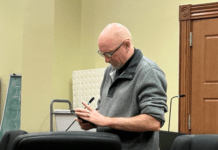
Fred Taylor sits at his desk at Crystal Health & Rehab Center in Plantation Key as he looks back at the day he was awarded the Medal of Merit by the Florida Cabinet and then-Gov. Rick Scott in 2018.
“It was a great honor, and it’s nice to get them, but I always want to remember the men who were with me who didn’t come home,” said Taylor, an Army veteran who served during the Vietnam War. “I came home for some reason. I don’t know why.”
Taylor received three Purple Hearts after sustaining injuries during combat. The first occurred April 1968 at a place known as Hamburger Hill with his unit, the 1st Air Cavalry. An ammo bearer for a machine gunner, Taylor was hit by a grenade with two pieces of shrapnel entering his leg.
Months later, June 11 to be exact, Taylor was hit with artillery shrapnel in combat. “It was a large piece of shrapnel that put a hole in my back,” he said “I couldn’t use my arms or legs for a while.”
The third injury was the most serious, he notes, as he was shot twice —by a sniper in a tree with an AK-47, which hit him in the right leg, and a .51-caliber machine gun, which entered his left foot.
“They (my unit) had to leave me there where I was shot because I was exposed. More could have been killed,” Taylor recalls. “They had to pull back and withdraw. It was up to me to crawl to where I could get help. If I remained there, I would have just died there.”
“My leg was north and south, but when I looked, it was going east and west,” he continues. “I had to rely on my Army training to get me out of there. There were times training was hard and you didn’t like it. Thank God I got it. I relied on it, and all I had left was my left fingers and heel. I had to crawl by clawing the ground and pushing with my left foot and heel. I eventually crawled to a spot where I could be rescued.”
Taylor ended up spending six long months recovering in the hospital in Washington, D.C., where he went through therapy and treatment. And while it was grueling and painful, Taylor recalls some pretty interesting moments during his stay.
“I took therapy in the hospital Monday, Wednesday and Friday,” he said. “We’d be in this giant room where they’d take care of lots of people. A lady used to lie on the table for therapy next to me as they’d freeze my knee and pack it with ice. It was painful, but I refused to get satisfaction in groaning and moaning.”
One day, Taylor said he was sitting and waiting for treatment when he got a pat on the arm from the same woman. “She said, ‘It’s very nice to meet you’ and rolled away. I thought I’d see her again,” he said. “One day I was laying on the bed when a nurse came in and said ‘What’s this about? You’re going to the presidential ward for what?’ I thought they had the wrong person, but she goes ‘Senator Smith requested you.’ I said, ‘Ma’am, I never met a senator.’ She goes, ‘Well, you have to go to the presidential suite tomorrow.’”
Taylor said he wanted to ask the lady who patted his arm down at therapy about it. But she never showed up. It wasn’t until his visit to the presidential suite that he saw the lady he met down in the therapy room. It was U.S. Sen. Margaret Chase Smith, who was the first woman to serve in both houses of Congress.
“I go, ‘Ma’am, I didn’t know you were a senator.’ She said, ‘We’re all patients. We’re all the same here.’ They lifted me up and put me on a chair, with my leg under an ottoman,” he recalls. “They brought silver cups and saucers and we started sipping on coffee, and she says she’s on the Senate Armed Services Committee and wanted to know more about the M-16 rifle since she wasn’t getting the straight story from the generals. I said ‘those magazines are crap. We couldn’t put more than 18 in because the spring wasn’t strong enough to push the bullets.’”
Taylor was called up two more times to meet with the senator before he was discharged Dec. 3, 1968. While wanting to wear his uniform upon leaving, he was told by the Secret Service that it wouldn’t be a good idea.
“Even with Purple Hearts and awards, they were afraid people would say bad things,” he said. “They went and bought me clothes so I could go home. I never wore my uniform after I was shot in June.”
Upon discharge, Taylor devoted much of his life to military veterans. And it’s led him to receive many awards and recognitions that include the James Dean Foundation’s Humanitarian Award; the National Infantry Association’s Order of Saint Maurice Medallion for his lifetime achievements on behalf of veterans; and the Sagamore of the Wabash by then-Indiana Gov. Mike Pence for his work across the state. He also received distinguished-alumni awards at his high school and college.
In 2000, he was elected National Commander of the Purple Heart organization to represent the interests of America’s combat-wounded vets. In 2013, he was recognized for volunteering 10,000 hours of service to vets.
Born in Galveston, Indiana, Taylor serves today as administrator for Crystal Health Nursing & Rehab on Plantation Key in Islamorada.
























